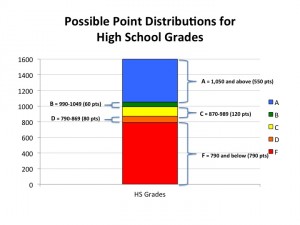Explaining Florida’s High School Grading System

Jacksonville Public Education Fund
B,C and D scores have a very narrow range on the Florida accountability system.
Yesterday we asked why there were so many A and B high schools, according to the latest grades.
The folks at the Jacksonville Public Education Fund have an answer in the chart at right.
It’s because the state grades have very narrow ranges on a 1,600-point scale and many school found a way to quickly add points.
School grades can rise if more students take accelerated courses, such as Advanced Placement, even if students perform no better on the Florida Comprehensive Assessment test or any of the grade’s other components. From their analysis:
All of the non-FCAT component sections above are assigned points based on actual 2011 achievement levels plus bonus points (or deductions) for gains from last year – so significant 1-year gains in Graduation Rate or Accelerated Coursework levels can significantly lift an overall score since those totals are weighted by 2.0, 1.75, and 1.25 respectively.
For any schools in the B, C, or D range – a bump of a hundred points or so from these areas can easily jump them up a grade with the FCAT or other areas staying the same. The diagram below shows total points needed out of 1600 for each school grade, as you can see the ranges that define a B, C, or D school are very small and do not take a huge change in total points to move between.
